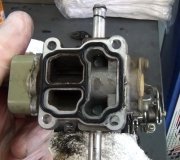I would go under the hood and see if the throttle cable is hanging up. Just find where it attaches to the throttle body, and move it with your hand to see if it moves free. You should find a throttle stop on the body that it hits when you release the cam.
Ok, after you are convinced that the cable is not hanging up, then lets talk about what controls the idle on your car.
The powertrain control module (PCM)/engine control module (ECM) controls the engine idle speed with the Idle Air Control (IAC) valve. To increase the idle speed, the PCM/ECM pulls the IAC pintle away from its seat, allowing more air to pass by the throttle body. To decrease the idle speed, it extends the IAC valve pintle toward its seat, reducing bypass air flow.
They make an IAC tester that allows you to extend and retract the IAC valve. Makes trouble shooting easy. If you fully extend the IAC valve, and the engine is still high, then you may have a vacuum leak causing the problem.
There is a IAC reset procedure, but not sure it is going to fix the problem.
Whenever the battery cable or the PCM/ECM connector or the PCM/ECM fuse is disconnected or replaced, the following idle learn procedure must be performed:
Turn the ignition ON for 5 seconds.
Turn the ignition OFF for 10 seconds.
Turn the ignition ON for 5 seconds.
Start the engine in park/neutral.
Allow the engine to run until the engine coolant is above 85 °C (185 °F).
Turn the A/C ON for 10 seconds, if equipped.
Turn the A/C OFF for 10 seconds, if equipped.
If the vehicle is equipped with an automatic transaxle, apply the parking brake. While pressing the brake pedal, place the transaxle in D (drive).
Turn the A/C ON for 10 seconds, if equipped.
Turn the A/C OFF for 10 seconds, if equipped.
Turn the ignition OFF The idle learn procedure is complete.
Hope this helps some.
SPONSORED LINKS
Saturday, July 22nd, 2006 AT 6:05 PM



